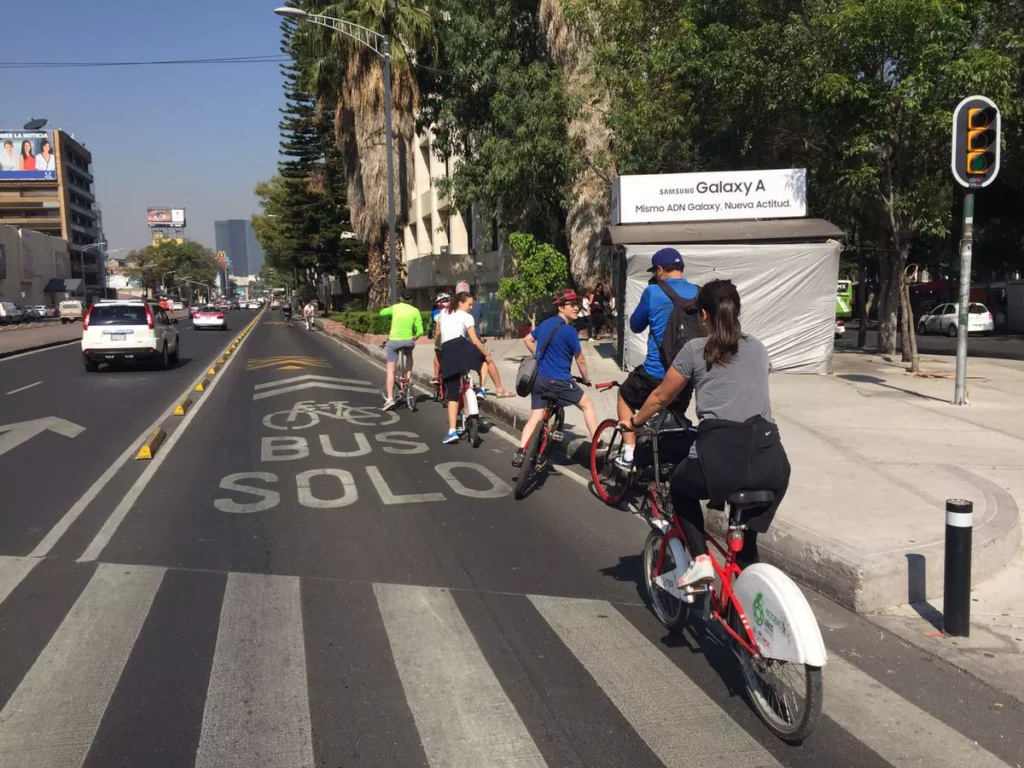The great cyclist dream is to have a city that allow free and safe bike circulation, as cycle paths. Having hundreds or thousands of miles doesn’t mean safety, over all if exist disjointed bikeways that provide none or minimum protection.
In 2024, Mexico City Government created over 142 miles of bike paths since 2019, a recognized number. Specially, if considered as the greatest cyclists’ infrastructure created since the previous 15 years.

Greater mileage, greater safety?
Mentioned that, is it mileage the same as safety? The answer is no.
Even if constructed more bike tracks, safety isn’t enough for cyclist due lane invasion by other vehicles or they take to nowhere.
In the first one of these cases, isn’t denied the use of shared bus-bike lane. The counter part is when this is shared with vehicles or public transport, cyclist can be run over. For that, is vital to have physical barriers as channelizers, confibicis or any other signage that clarifies the cyclist preference or passage.
We know the difficulty to install these barriers in shared lanes, however, these must be in permanent bikeways.
In order to have separated bikeways from traffic of cars is essential to provide greater safety to cyclist. The maintenance of these exclusive lanes as constant street patching to implementation and reposition of cyclist road devices as those already mentioned are some examples.
Nevertheless, even though bikeways have these elements, there’s something really important missing, avoid disjointed bikeways.
Disjointed bike routes, the great challenge
Even though the bikeway is delimited by vertical and horizontal signage and devices, must be useful. But how to know if is useful or not? you might be asking.
Answer is simple: bikeway must connect with different interest and useful points. These points are metro and metrobus stations, hospitals, museums, malls, business, tourist zones and others. In case of don’t connect with these zones, must connect with other bikeways that allow user to arrive to them.
The purpose is to create safe bike ways that protect cyclist and allow to ride all the city by them.
In this way, disconnected bike routes are the challenge to defeat. And authorities must try to connect constructed ones and create an integrated network.
In other words, there’s no case to have 1 or 10 physically protected bike lanes disconnected among them, or worse when ending these exclusive spaces, cyclist must ride several miles (to other neighborhood) to find another bike route.

Beyond city, there’s city
Another mistake that many authorities commit as many of us… Believe that CDMX is just conformed by municipalities as Cuauhtémoc, Miguel Hidalgo, Benito Juárez and Coyoacán where it centralizes the biggest part of tourism, office zones, places with high influx, and housing as the famous Roma and Condesa neighborhoods.
In these places concentrates the greatest part of physically separated bikeways, as the interconnected ones that are the longest and most important.
For example, bikeway of Reforma Avenue with Floresta-Monterrey-Parque España-Nuevo Leon and of course Insurgentes, is the longest one of capital city.
Even though some of them connect with smaller ones as Rio Rhin or Niza, and others also important as Revolución and Horacio Avenue in Polanco, which are nearby but disconnected.
Now, on the other hand, if we mention the one placed in Circunvalación Avenue (Iztapalapa), Santa Catarina (Tláhuac) or México avenue (Xochimilco), is about disjointed bike routes in CDMX that doesn’t help cyclist to arrive to the other Mexico City.
That’s why is important the cyclist lane interconnection among them. Is not enough to have a bike way, but must be useful and provide the necessary safety to ride on it at any part of the capital, not only as an exclusivity of certain zones
186 new miles, a solution for disconnected bikeways?
A main mobility purpose of the future CDMX head of state, Clara Brugada is create 186 new miles of bike paths. Likewise, the implementation of the EcoBici program in each of the 16 municipalities that are part of the capital.
“Ride by bike will stop being a privilege for those who live in centric municipalities of the city”, Brugada said, in accordance with this mileage that can be set on municipalities with poor cyclist infrastructure required for their citizens.
Informed in the most recent forum “intelligent and sustainable mobility”, where also said that will increase from 10 to 50 bike parkings in the metropolis.

